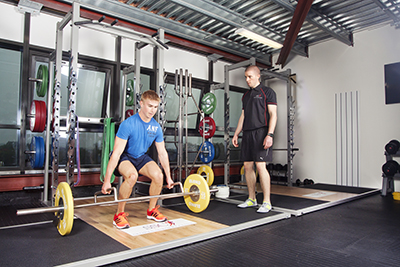Overuse injuries are common for runners due to high volume or high intensity running with poor posture and poor running mechanics. Weaknesses or poor muscle activation in the trunk, hips and ankles can cause problems elsewhere as these areas assume greater load than they are able to tolerate.
More energy is consumed to fuel poor running mechanics. Athletes often find they cannot go faster or in fact fatigue prematurely in a race no matter how hard they train. Every time they hit the ground they leak energy from the body due to poor strength and control. This can be worth several minutes over a marathon distance.
At the UPMC Sports Surgery Clinic, we prescribe strength exercises to runners whether they are recovering from injury or seeking to improve their performance. Strength training has been shown to improve neuromuscular function, increase the percentage of fast-twitch fibres and improve tendon stiffness – all of which contribute to faster and more economical running, as well as reduced injury risk.
Many runners are fearful of doing strength training mainly due to lack of available knowledge to them. We address some myths surrounding strength training below:
It will slow me down
Strength training under heavy loads or explosive movements increases the recruitment of fast-twitch muscle fibres. You need more of these fibres to run fast! Being able to utilise these fast twitch muscle fibres in conjunction with good cardiovascular fitness with improving an athlete’s speed and efficiency particularly at faster paces and longer distances.
I will get too big
This is a common fear, particularly among female athletes. A properly designed strength-training programme should not allow this to happen. Whole-body exercises appropriate to the athlete and using the right repetition ranges will ensure that strength is achieved without increased muscle size. The key aim of a strength programme should be to train the movement, not just the muscle!
I’m in my 50’s and too old to start strength training
It is never too late to start some form of strength training. Strength training can help to maintain muscle and bone mass and improve metabolic function, which is important for long-term health. For the middle to late age runner, strength training can help them reduce injury risk, improve coordination and performance.
I’m only new to running
This is the perfect time to begin strength training. Many beginner runners develop lower limb injuries in their first 3 months as they place stress on muscles, tendons and bones that are not accustomed to that stress. By adding some strength training in conjunction to a graduated running programme, they will develop the motor skills necessary to run with good biomechanics and reduce the risk of injury.
The athlete is only a teenager and it will stunt their growth
A young adolescent or pre-adolescent athlete doesn’t necessarily have to lift weights to improve strength. They can develop strength and co-ordination through whole-body, multi-joint exercises at their own body-weight. Once a good movement base has been developed then some load can be added using a medicine ball, dumbbells or an Olympic bar.
Designing a Strength training programme
A strength-training programme should be appropriate to the athlete and the level they are at. A typical programme should begin with a warm-up consisting of:
· Mobility exercises including foam rolling and dynamic stretching
· Muscle activation to ‘switch on’ hip muscles, core and ankles
· Movement preparation exercises to prepare the neuromuscular system
The strength exercises should cater to your individual needs at a weight that you are challenged but able to maintain good technique at. The repetitions can be between 4-8 with 3-4 sets and 1-2 minutes rest between sets. As a rule of thumb, it is best to sequence the exercises so that the biggest whole body movements at the beginning when you are fresh. Two strength-training sessions per week is sufficient and must fit appropriately into the overall training programme.
For the more advanced runner with a good strength base developed, they can include some explosive power exercises such as Olympic lifts or a variation of one, box jumps, bounding and single leg hops. These exercises place high stress on the central nervous system and should be done at the beginning of the session and allow longer rest recovery periods between sets.
Check out our
RUN Sport and
The Edge for Runners programmes at SSC where runners can benefit from one-to-one or group sessions with an individually designed strength training programme, as well as improving running technique.
| For more information or to book an appointment with Colin Griffin Phone +353 1 526 2030 or Email sportsmedicine@sportssurgeryclinic.com |


